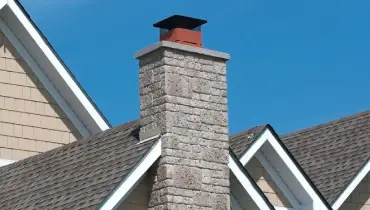
Creosote is a carbonaceous chemical formed as a byproduct of a fire burning a natural fuel, like wood. Homeowners are most likely to encounter creosote in chimneys. In a home, creosote exposure is linked to health problems, but it’s also a sign that a chimney is not functioning properly, putting your household at risk of smoke exposure and fire damage.
Creosote vs Soot
Soot and creosote are often mistaken for one another, but they are very different byproducts of fire. Soot is a black powdery substance that is generally composed of carbon, produced by the incomplete burning of organic matter.
On the other hand, creosote is a dark brown residue that sticks to the inner walls of chimneys and stovepipes. It can appear flaky, sticky, or shiny, and hardened to the surface. Creosote is very combustible due to its flammable compounds, such as phenols and cresols.
How Does Creosote Buildup in a Chimney?
Creosote buildup in chimneys is dangerous because it occurs over time. A small amount of visible creosote equates to a growing problem.
Creosote buildup in chimneys is measured in three levels of increasing severity.
- First Degree Creosote
First-degree creosote is a light powder that is soot-like in appearance. First-degree creosote may be easily removed with a chimney brush. The first-degree buildup occurs in ideal conditions, where the fire has lots of air, and heat flies up the chimney.
- Second Degree Creosote
Second-degree creosote generally occurs in wood stoves and fireplaces with glass doors. The buildup is tougher to remove and looks like shiny black flakes.
- Third Degree Creosote
Third-degree creosote buildup is the most serious. It occurs when flue temperatures are low, and fuel combustion is incomplete. It looks like tar coating and can result in chimney fires.
Four Causes of Creosote Buildup
Not all fires are created equal. Creosote builds up in chimneys for four key reasons:
- Cool flue temperatures – When your flue is colder than average, smoke will condense, causing creosote to form quickly on inner walls.
- Oversized flue – If your home has an older fireplace that’s vented into a masonry chimney, your flue is probably too large to support the fireplace. That gives the smoke a long time to linger and create creosote buildup.
- Restricted airflow – While too much airflow can lead to creosote buildup, not enough airflow can, as well. If you close the glass doors on a fireplace or stove too tightly, the restricted airflow increases the residence time and enables creosote buildup.
- Use of unseasoned firewood – Firewood that has not been adequately dried contains water, which means when it’s burned, the fire doesn’t get as hot. Since the fire is using energy to dry the moisture, the cooler flames result in more condensed smoke, which leads to creosote caking in the flue.
Focusing on using best practices for your fireplace will help you decrease the buildup of creosote in your chimney between cleanings. We recommend a chimney inspection once a year.
How to Get Rid of Creosote Buildup in Chimneys
Creosote must be broken down by a chemical treatment. As winter approaches, we recommend hiring a professional chimney sweep to clean your chimney of all soot and creosote. In the unfortunate event of a chimney or house fire, remember that Rainbow Restoration delivers reliable smoke and fire damage restoration services. Learn more about our fire restoration services.
